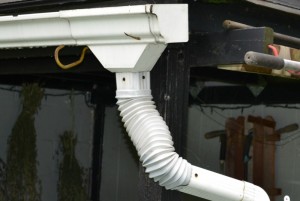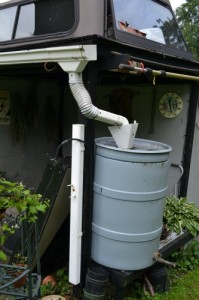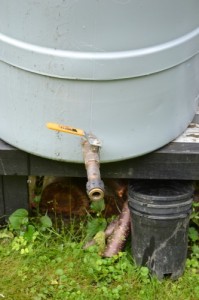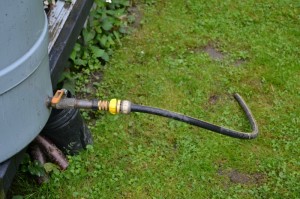Natural rainwater is an excellent resource for just about any activity that requires water. Gardening, laundering, bathing, and drinking can all be done with natural rainwater, as long as proper cleaning is practiced prior to use.
Although it may take a bit of extra money for the initial setup of a rainwater harvesting system, you can save usually between 30 and 50 percent on you water bill by using natural rainwater.
Rainwater is typically very clean, and best of all, it is absolutely free. Collection of rainwater will improve self-sufficiency and may also be extremely beneficial in case of emergency.
1. Research the Laws for Rainwater Collection in Your Area
Laws for the amount of rainwater that can be collected without a permit vary from state to state. Most states have some type of regulations in place for rainwater collection.
Some states have more strict guidelines and laws in place than others, while a few states have made collection of rainwater altogether illegal.
For this reason, it is important to look into the laws regarding rainwater collection in your area. It may be worth looking into getting a permit to collect rainwater if you plan to collect a large amount.
2. Gather the Necessary Equipment
The largest piece of equipment that you will need is a barrel to collect rainwater in. Choose a barrel design that will sufficiently hold large amounts of water without risk of leaks or contamination of toxic materials.
There are types of barrels that are made specifically for rainwater collection. Ideally, a barrel will not have any toxic materials, be securely covered and screened, and be accessible for cleaning.
Find a spigot to attach to the bottom of the barrel and make sure that it is screwed in finger tight in order to prevent leaks. You will also need some hose, a hose adaptor, mesh, a jigsaw, and a wrench to build a basic water harvesting system.
3. Build Your Rainwater Harvesting System Correctly
 Most of the time, harvesting systems will work at their optimum level when placed beneath the gutters of your house. Place a 50 to 60 gallon metal or plastic barrel beneath the gutters on top of a strong and flat surface.
Most of the time, harvesting systems will work at their optimum level when placed beneath the gutters of your house. Place a 50 to 60 gallon metal or plastic barrel beneath the gutters on top of a strong and flat surface.
Consider creating a stand specifically for the barrels to sit on. A flat and raised surface is best for the barrel because you will need access to the spigot at the bottom of the barrel.
Attach a mesh screen to the top of the barrel to act as a filter for the incoming rainwater. Use as fine of a mesh as you can, or try layering a few mesh pieces on top of each other.
Filters that are specifically designed for rainwater collection can also be purchased. It’s important that the water be filtered to be as clean from bugs, leaves, and other toxins as possible before entering the barrel.
Place a tap or spigot at the bottom of the barrel to release the rainwater when you are ready. Consider purchasing a hose attachment to your spigot if you will be using the water for gardening purposes.
4. Check the Surface of Your Roof
Certain types of roof surfaces and materials may add extra chemicals and toxins to water that comes into contact with it.
Asphalt shingles are generally unsafe for rainwater collection, as they will likely pollute water with toxins.
Steel sheets, fire glazed tiles, concrete tiles, cement tiles, and clay tiles are popular choices for those who wish to collect rainwater, as they are certified for rainwater collection.
5. Close Off Your System as Much as Possible
Sitting water can be a breeding ground for mosquitoes and other types or bugs, so it is important not to leave the top part of your barrel open, especially if you live in a tropical climate.
Other animals like frogs and lizards will be attracted to stagnant water, too. The best way to keep your water harvesting system closed off from bugs and other animals is by connecting a hose or tube directly from the gutter to the barrel.
This will allow the water to flow straight into the barrel without leaving any part of it open for outside creatures to use.
Closing off the system with a hose can also make collection of rainwater more efficient because there is no run off that won’t be caught by the barrel.
6. Consider Installing a Greywater System
Greywater is home waste water from all sources other than toilets. Greywater systems can take water from showers, sinks, washing machines, and dishwashers and recycle and retreat it for purposes that do not require drinking water quality.
This can be a great way to recycle and save on water bills in addition to rainwater collection. Additionally, rainwater can be run through these systems in order to filter it again if you are very concerned about the quality and cleanliness of your rainwater.
7. Be Safe
It’s important to keep the rainwater harvesting system on a flat surface that will be able to hold the weight of the water that you plan to collect.
You don’t want the collection barrel to tip over when it’s full. Keep your gutters clean if you plan on collecting rainwater runoff from this area.
The less leaves and dirt there are in the gutter, the fewer contaminants there will be in the rainwater that runs off of the roof. If there are too many contaminants, the rainwater may be unsafe to use for certain things, like drinking.
8. Make the Most of Your Collected Water
Most water that is properly cleaned and stored can be used for things like cleaning, gardening, laundry, or bathing. You need to be extra careful when using collected rainwater for drinking.
Improperly cleaned and filtered water can be dangerous to drink and cause serious problems. Only use collected rainwater to drink if you are absolutely sure that you have filtered it properly and that there are no contaminants in it.
Consider testing the water if to be sure it is safe to drink.
9. Keep Up With Proper Maintenance
Quality water can only be achieved when proper care is taken of the rainwater harvesting system. Gutters, rain heads, water diverters and barrels should be cleaned on a regular basis and serviced regularly.
Consider registering your water collecting system with your local council.
Fortunately, the collection of natural rainwater has many benefits and nearly no drawbacks. Whether being used for gardening, bathing, drinking, or laundry, rainwater can replace the need for depending on outside companies to provide water.
Collecting rainwater will promote self-sufficiency, be beneficial in case of emergency, and allow you to save up to 50 percent on your water bills.
As long as rainwater collection is gone about in a proper and safe manner that follows laws and guidelines that are set in place in your area, collecting rainwater can be an important part of staying green, while cutting back on costs.



The rain harvesting systerm like rain barrel is a useful way to save rain water. It is cheap, water saving and environment protection. htcn.com
I am in the process of building a (3) 5 gallon bucket biofilter. Have you seen this simple but effective filter? I was thinking of uniting the tow together? I am building one at home. So I can reconstruct them in countries without clean drinking water. The 3 buckets would be set up on blocks. Including the blocks would rest a total of 6 feet off the ground. I suppose I would have to support the 50 to 60 Gallon Barrel above the existing biofilter. I believe a gallon of water weighs 5 pounds. Thus a platform would have to be safe to Hold up at least 300 pounds? As I will not be able to attach the platform directly to the home, What do you recommend for a platform? Also how would you connect the the two?
Barry,
My thoughts are 4 by 4′ sunk into the ground and even a concrete footer below the posts so they couldn’t sink more with the weight, then build heavy duty on top of that to make a platform.
I like that you mention getting the right equipment. My brother is looking to get some rainwater tank cleaning done from a professional but needs tips. I’ll be sure to talk to him about hiring a professional with the right equipment.
Thanks for your comment about how you can cleanly collect rainwater by using a barrel. I like how you said that it’s a good idea because you can save water in the event of an emergency. My husband and I want to be prepared, so we are looking into rain barrel collectors.
One thing I didn’t see in your article was a warning not to make your platform with concrete blocks. The plastic of the barrel and the concrete create a chemical reaction turning the water black and rendering it unusable.. I still have the platform of concrete blocks but topped it with a plywood and 2 by 4 small platform. I use mine for garden watering, laundry and flushing the toilet. Carrying a 4 gallon bucket inside keeps me muscles strong. Thanks for you article!
Well . . . I’m not sure about that, but . . .????
I don’t drink the rainwater from my barrel but use it for flowers and garden.. I have asphalt shingles. Is it okay to use the water for these other uses.? I wonder what percentage of houses have asphalt shingles nationwide. In my area it is probably 99%.
Bob,
I’m not expert in this area but I would think that after years and years the asphalt shingles are give up very little of the asphalt materials in the run off. But I would not drink the water for sure.
Your article’s info regarding asphalt shingles being unsafe is not founded in studies on safety, and is an assumption. Please correct the information to include asphalt roofs in the list of safe roofs. Wooden or thatched roofs are actually unsafe. My research has lead me to believe asphalt roofs are just as safe as metal roofs for collecting rainwater.. See here, for example.: http://www.thecenterforrainwaterharvesting.org/2_roof_gutters3.htm
Thanks Susan. Fact is there is asphalt everywhere that leads to water collection sites. If I was in a situation where all I have is water from my asphalt roof I would drink but right now I only use for my gardens.
Hi,
I don’t, but we have rainwater systems like that at home in New Zealand. We collect the rainwater and often use it in the house as well. We have the underground tanks or huge circular concrete tanks- about 6″ high and I don’t know the circumference – but large. and we use the water runoff from the roof. We do have completely different roofing options than you do here.
Good luck – There is a woman who worked out a whole watering system that used rainwater runoff, into tanks and then ran it to feilds – but I am not sure if I read it here on the board or on one of my classes.
I save 1/2 gal. Orange juice jugs with screw on lids to take water from my rain barrels to other locations and house plants, cemetery, and flower boxes. Have about 20 bottles on hand and fill in my spare time. Helps to keep water level down for the next rain storm
I am considering installing a rainwater retention system utilizing a large septic=type tank at the rear of my house. I plan to put a shallow-well pump on this tank to provide water for my garden and animals. Does anyone have a source for this type of system in NW Illinois?
I live in a totally different climate then. You. I live in Calif.. I have been researching for several months. You might want to try Loomis tanks. They have an extensive line of products. They have locations all around the country. Their prices are reasonable as well. You will probably need a cistron or a septic tank to go under ground so it will not freeze in the winter. If you have Home Depot there you may want to check with them. Their prices are competitive within line pricing and no shipping if you pick up in the store. Most of their tanks are above ground. But, worth a try. Good luck!
Mike,
We have rain barrels all around the house and garage. I truly didn’t know some states have regulations — unbelievable! I use it to water (I use the lower faucets) my plants and a few have hoses attached to the continuously feeding water to our ponds. This helps because the barrels fill up quickly when it rains.
I, also, collect the water from the faucets when I’m waiting for it to warm up for showers or washing dishes. I use it to water houseplants and also my roses with banana peels around them on the ground. Thanks for you tips, your donkeys are adorable.
Cindi
In Colorado pot may be legal, but it is against the law to collect rain water due to the
people who have water ‘rights.’
I would consider a rain harvesting landscape with lots of organic matter in the soil, micro swales and raised beds on contour that would spread the water across your landscape and sink it into your soil. The best rain barrels hold ~275gallons using IBCs but good soil can hold tens of thousands of gallons per acre.
You would not be “collecting” rain water in barrels, just a water wise landscape.
I save water from my central air conditioner. There is a drain pipe on the outside of my house and i keep a five gallon pail under the drain. During the summer i get lots of water.
The very FIRST thing you need to collect rainwater, is RAIN!
We don’t get much here (San Diego), and what we did get, was months ago. The collected water also has been gone for months; 3 55g barrels and a 200g tank were emptied in about a week of moderate watering (pots, raised bed garden and fruit trees; no lawn). Have no idea where we could store more, either.
I have been thinking of adding a pressurized system inside the house to utilize the shower water a second time for toilet flushing. I have a well but still have to pay sewer charges….this would probably reuse nearly half of the house water
Mike,
I was actually looking into installing a Greywater System. Do you have experience with doing this?
Thanks,
Matt Sullivan
Matt, I don’t, but it’s something we should look into. Thanks for asking, -Mike McGroarty